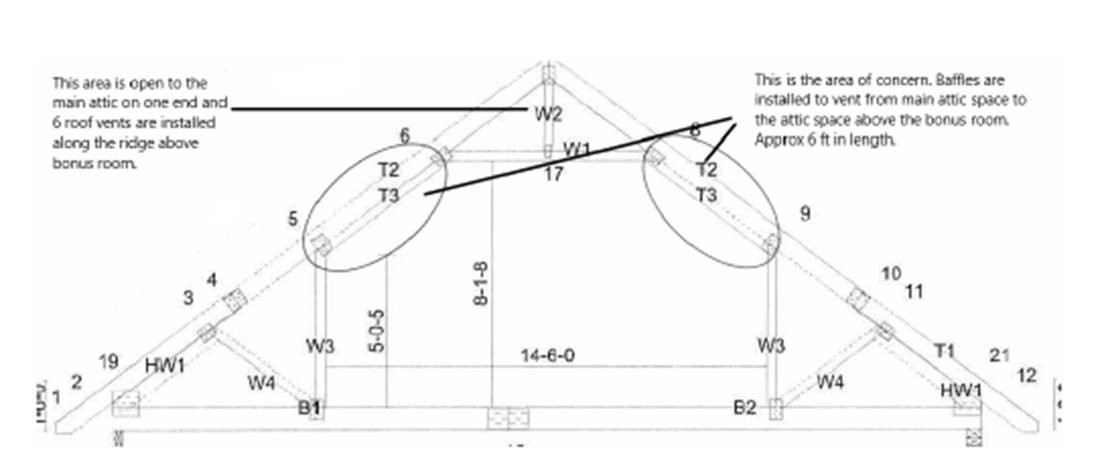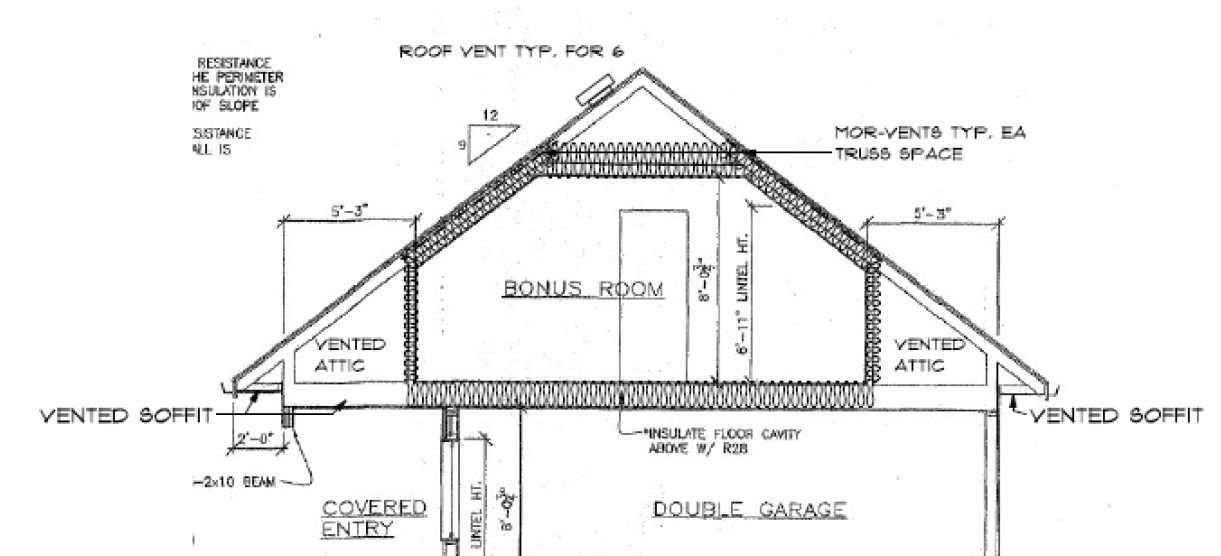BCAB 1855 - Roof space ventilation
Roof space ventilation
Project description
The project is residential house with a conditioned space (bonus room) constructed above the attached storage garage. The bonus room above the garage has about 60% of its ceiling area sloped (vaulted). The top chords of the roof trusses act as roof joists, and the individual truss/joist spaces of the sloped ceiling area are not interconnected by cross purlins above.
The depth of the truss space cavity from the finished ceiling to the underside of the roof sheathing is approximately 280 mm (11 inches). Truss spaces are full of batt type fiberglass insulation. Styrofoam baffles between the top of the insulation and the roof sheathing in the locations identified in the diagram (it is unknown if baffles are installed in every truss space). The Styrofoam baffle is not the full width of the truss spacing and provides a clear channel of approximately 180 mm wide and 25 mm high, which is intended to provide air movement from the openings in the eaves at the lower attic space to the ridge venting in the upper attic space.


Applicable Code Requirements
Sentences 9.19.1.1.(1), 9.19.1.3.(1) and (2) of Division B of the British Columbia Building Code 2018.
9.19.1.1. Required Venting
1) Except where it can be shown to be unnecessary, where insulation is installed between a ceiling and the underside of the roof sheathing, a space shall be provided between the insulation and the sheathing, and vents shall be installed to permit the transfer of moisture from the space to the exterior. (See Note A-9.19.1.1.(1).)
9.19.1.3. Clearances
1) Except as provided in Sentence (2), not less than 63 mm of space shall be provided between the top of the insulation and the underside of the roof sheathing.
2) At the junction of sloped roofs and exterior walls, where preformed baffles are used to contain the insulation, the baffles shall
a) provide an unobstructed air space, between the insulation and the underside of the roof sheathing, that is
i) not less than 25 mm in dimension, and
ii) of sufficient cross area to meet the attic or roof space venting requirements of Article 9.19.1.2., and
b) extend vertically not less than 50 mm above the top of the insulation.
Decision being appealed (Local authority’s position)
The local authority has determined that the insulation and the required venting of the subject area comply with current BC Building Code requirements. The local authority considers the intersection of the attic trusses web and top chord to be similar to the intersection of a sloped roof and an exterior wall, with venting requirements complying with Sentence 9.19.1.3.(2).
Appellant's position
The appellant maintains that the sloped/vaulted area of the subject ceiling must comply with Sentence 9.19.1.3.(1), where a not less than 63 mm is required between the top of the insulation and the bottom of the roof sheathing.
Appeal Board decision #1855
It is the determination of the Board that Sentence 9.19.1.3.(2) is not applicable and that Sentence 9.19.1.3.(1) is an applicable Code requirement to satisfy the ventilation of the attic and roof spaces above the bonus room.
Reason for decision
The exemption for the use of baffles described in Sentence 9.19.1.3.(2) is intended to contain the insulation to ensure the required open ventilation area is not obstructed; specifically, at the junction of an exterior wall and sloped roof. The Board considers the installation of baffles the full length of the sloped ceiling area to be beyond the exemption described in Sentence 9.19.1.3.(2). The design does not provide the required ventilation as per 9.19.1.1.(1) for the insulated sloped ceiling area.
Lyle Kuhnert
Chair, Building Code Appeal Board
